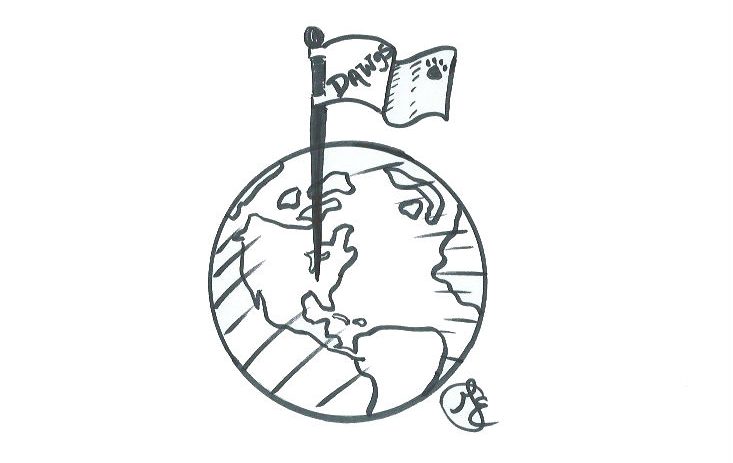“Dawgs From Around the World” Illustration courtesy of Gabbie Evans
BRIDGET EARLY | OPINION COLUMNIST | bfearly@butler.edu
When Butler University was founded in 1855, it was on a then-radical platform of inclusivity regardless of gender or race. Today, Butler continues to advertise its inclusive and caring culture– and every blonde, Christian business major on campus could tell you without question that they always feel loved and accepted at Butler.
Students that fall into any one of a number of minority bodies on campus, however, would certainly disagree with the facade Butler continues to maintain. The real issue of diversity and inclusivity at Butler is much more deeply rooted than a simple school pride or surface level support.
Despite promotional advocacy for a multicultural community, only 13 percent of the campus identifies as non-white. In its past two visits, the Higher Learning Commission– the organization responsible for giving accreditation to over a thousand institutions across the country– has given Butler low marks for diversity, a blow that could potentially sink Butler deeper into a cycle of uniformity if the university’s accreditation is ever put in jeopardy.
In order to counteract the discrepancy between Butler’s aspirations for diversity and the reality of the situation, Butler administration has officially approved a new addition to the CORE curriculum: a Social Justice and Diversity requirement.
Unlike classes that are designed specifically to meet the CORE requirements, such as the infamous Music in Action PCA, the SJD requirement would be a reclassification or “seal of approval” for preexisting classes rather than the creation of a completely new set of classes.
The course will be structured most similarly to the Indianapolis Community Requirement, functioning as an addition to preexisting courses across all colleges. The additional information will seek to examine the history and foundations of both discrimination and minority contribution behind the actual premise of the class.
James McGrath, the faculty director of the CORE Curriculum and a professor of religion, is optimistic that the addition of a course that interweaves a thread of minority excellence will prove instrumental to expanding students’ world-view and helping them to recognize the importance of multicultural contributions to society.
“I think that requiring a course that’s focused in social justice and diversity is crucial and makes sense in the current context of our society and also because of what our founding institutional values emphasize,” McGrath said. “By changing the curriculum and helping to support new courses that emphasize multiculturalism, we may have the opportunity to find an entry point into this closed loop of a problem and ideally will be able to begin to change how welcome marginalized groups of students and faculty feel on campus.”
First-year psychology major Aine Montgomery is more skeptical, however, recognizing that the problem goes so deep as to have the “fishbowl” officially known as the Efroymson Diversity Center stuffed heedlessly in the basement of Atherton Union.
“There are key individuals on this campus that recognize that there is an issue, but I personally feel that the institution as a whole “fake cares,” meaning they only acknowledge the problems when we draw attention to the problems,” Montgomery said.
The problem is also deeply rooted in money. Butler boasts highly successful graduates who continue to donate to the university post-graduation. But requisite expectation that accompanies donations is the understanding that the donor’s opinions will be respected – especially the opinions of those who make generous contributions.
“Butler picks and chooses what they choose to be culturally aware of. They tread lightly because they don’t want to step on the toes of the people who give them money,” Montgomery said.
Terri Carney, a faculty mentor for the new requirement and a professor of Spanish, is optimistic that the new requirement will also help professors to grow. By building new courses and deepening their understanding of the contributions made by minorities to their own fields, Carney believes faculty will then be able to translate their understanding to the growth of their students.
“It’s one thing to develop a course that’s all about [social justice and diversity], but it’s a far more profound thing to examine your own curriculum and determine what you can do to improve it and incorporate aspects of social justice and diversity that are applicable to your field,” Carney said.
Implementing a program that expands the worldviews of both students and faculty will be extremely beneficial both as a way to complete the foundation of a liberal arts education, as well as a way to improve the overall Butler community, break the vicious cycle of overwhelming similarity, and bring in new faculty and students that will grow the diverse community.
Despite the numerous and varied opinions on the introduction of the new requirement, the one recurring sentiment both students and faculty recognized was that Butler most certainly needs to change. At a school whose foundations are based on inclusivity and equity regardless of differences, Butler cannot continue to minimize the presence and power of the minorities who make us special.



